 Facebook
Facebook
 X
X
 Instagram
Instagram
 TikTok
TikTok
 Youtube
Youtube
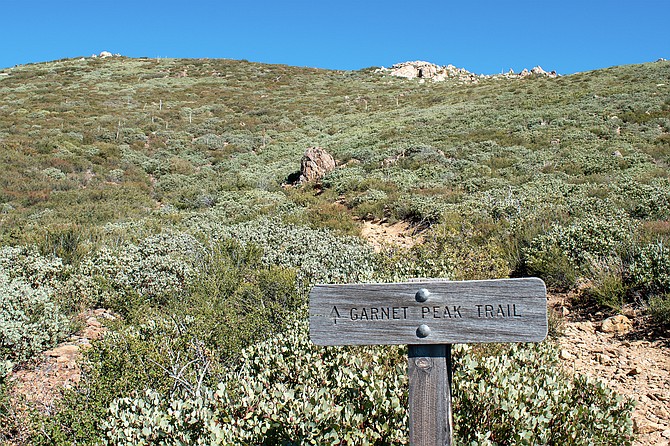
“Are you going to write about this hike?” My buddy Joey asked as we stood atop Garnet Peak.
“I dunno,” I responded. “It’s not a very hard hike and it’s got like a thousand reviews on AllTrails. And it’s probably one of the most popular trails near Mount Laguna.”
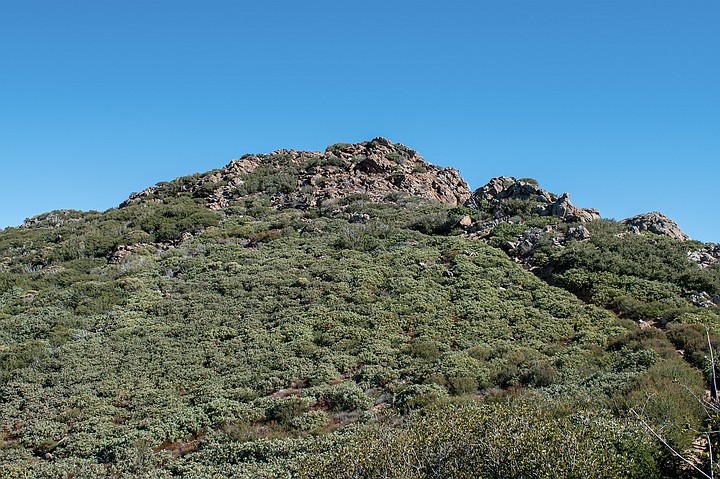
Joey nodded but didn’t respond. Instead, we both fell silent as we surveyed the horizon. The wind was blowing from the east, beating against the side of the mountain. I was standing on a steep rocky precipice listening to the wind howl as it climbed up the mountains’ roots that grew out of the desert valley below. The wind was icy, but not fierce enough to prevent me from taking in my surroundings. I had at my command a wide view and could see San Gorgonio and San Jacinto nearby to the north, as well as several familiar desert peaks, including Toro Peak, Villager’s Peak, Whale Peak, Granite Mountain, and San Ysidro Mountain. To the east, I could see the Salton Sea about 40 miles distant and 6,000’ below me. It was partially hidden behind a layer of chalky haze.
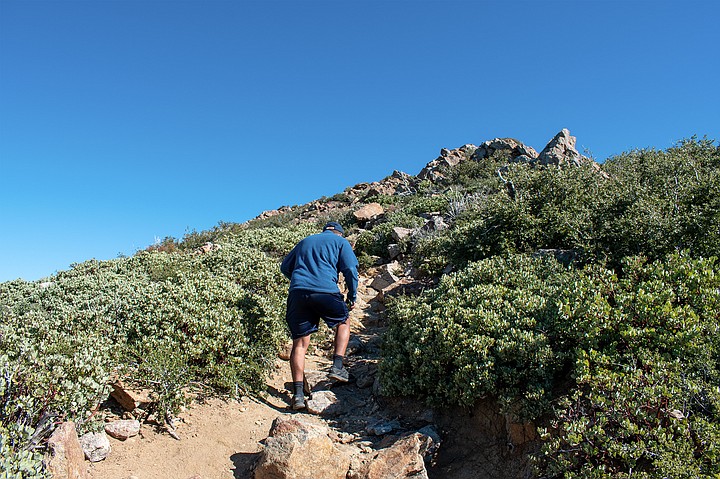
With a terrible shriek a gust came over the mountain and I heard a deep echoing boom below me. Carefully, I took a step closer to the edge. Then another. The wind clawed at my boots and I leaned slightly forward to look off the side of the mountain. As I did, the slope seemed to slip away into cracks and gullies and the longer I stared the more I felt a chilling sensation settle in my bones. I tried to shake the feeling by turning southeast to face the sun, but the Laguna Mountain range no longer stood still, instead it seemed to swell and I had the bizarre impression that I was standing on the crest of a massive tsunami just before the wave broke.
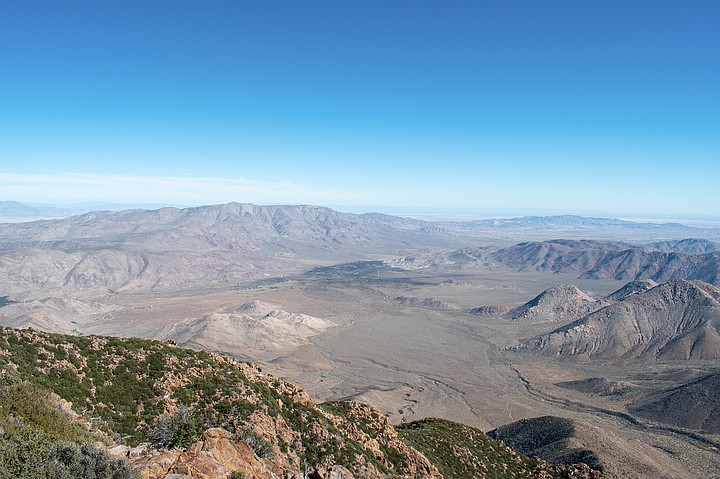
“Do you ever get the urge to jump?” Joey asked. His eyes widened as he cautiously poked his head over the ledge to peer off the side of the peak. It was a very long way down.
“Mhm,” I hummed while stepping away from the ledge. “The French call it l’appel du vide or call of the void. It’s their name for that tiny scratch in the back of your skull, urging you to plunge into the abyss while standing on something high up.”
“Damn,” mused Joey.
“Nah, it’s normal. I read that it’s your brain realizing you could die, but then deciding not to. It’s actually a good thing because your brain is making a decision to stay alive. But don’t quote me on that.”
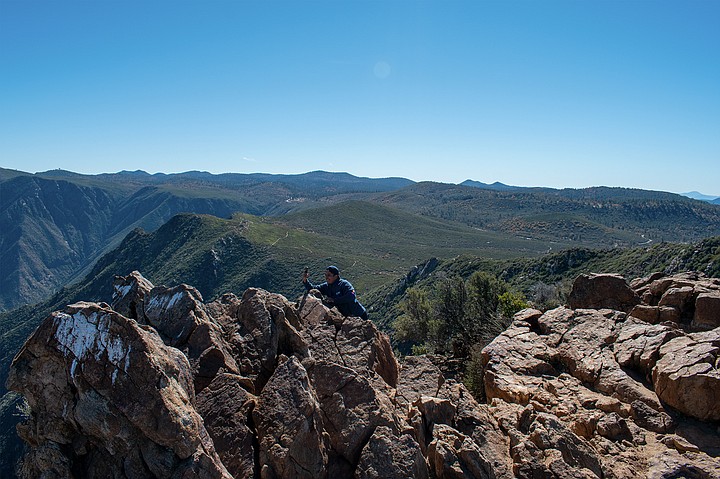
Despite the terrifying drop beneath him, Joey took out his phone and started filming. As he moved the camera around, he eventually settled on a motion that he liked and spent a few minutes rehearsing it for Instagram. I decided to follow suit and snapped a few photos myself. Alone together, we both fidgeted with our devices as a few scattered clouds quietly drifted by high above. They were thin and wispy, as if they had been gently brushed across the sky.
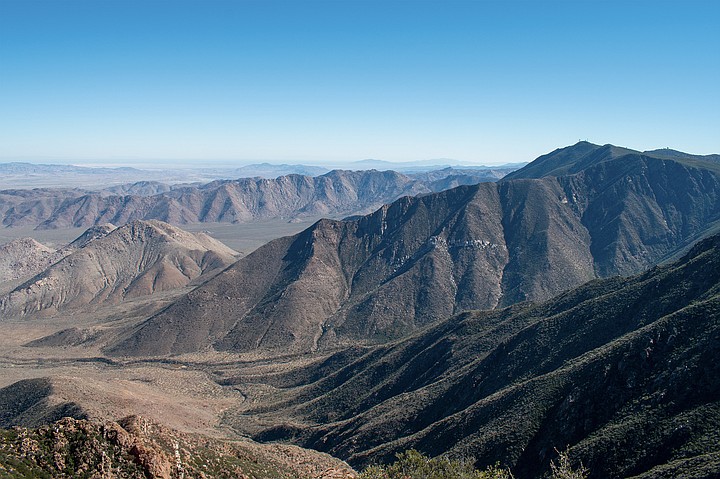
It had taken us a little under a half hour to reach the top. The trail was easy to follow and we walked at a conversational pace for most of it. Because the hike was so casual, I wore a long sleeve shirt and a cotton sweater instead of my usual sweat clothes. This kept me warm for the first half of the path as we meandered past various chaparral and a peculiar ash-colored shrub before ducking under a row of pine trees. But I did break out in a light sweat as we started along the last half of the trail, where the path turned upward and intersected with the Pacific Crest Trail.
To my surprise, the well-known trail was well-trodden. Backpacking along it was a 30-something couple traveling south. They were from the U.K. and had started months earlier at the Canadian border and were now close to wrapping up their adventure at the southern terminus in Campo. Both hikers looked like they had been on the trail for some time as the man had a bushy mountain beard while the woman had a sun-kissed glow unique to surfers and thru-hikers. Both looked agile and sinewy and were friendly enough to wave goodbye as our paths diverged.
As they disappeared from sight, Joey and I started our short ascent. The trail was composed of loose rocks that gave way to larger stepping stones near the top, with an easy scramble at the end. Between these last two sections, there was a nice moment where the trail cut through a field of manzanitas, atop which squatted the stony peak. From this vantage, it was hard to believe that the backside of the mountain fell away into the desert abyss.
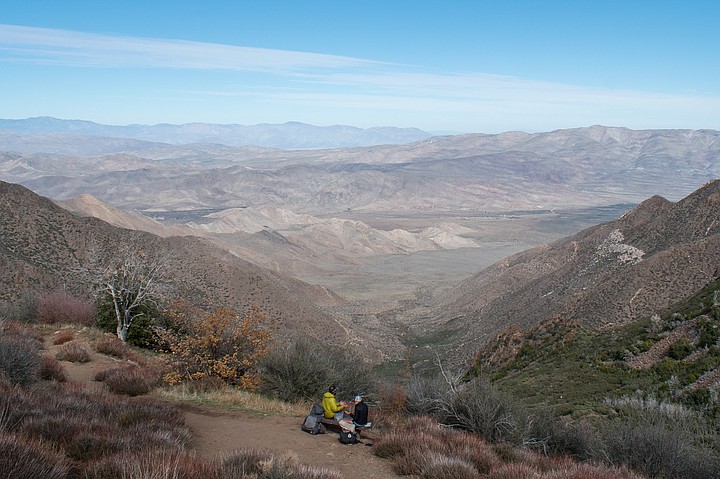
Technically this hike is listed as moderate difficult in Jerry Schad’s Afoot & Afield San Diego County and on AllTrails, but this time of year it was an easygoing affair. The hardest part was finding the trailhead as Google Maps took us to the wrong spot and we had to backtrack south a thousand feet. The parking area was little more than a dirt shoulder on the side of S1 where six competent drivers could park; though I often wonder if San Diego has that many. There were no other cars when we arrived late in the morning, but there was a shiny Mini Cooper crouched in the brush on the way out. On the off chance that there is no parking at the Garnet Peak Trailhead, you can park at the Penny Pines Trailhead half a mile south. I recommend starting here for three reasons: there’s more parking; the hike is longer, spanning about 4 miles instead of a measly 2.3 miles; and most of the trail is on the PCT, meaning you can humblebrag to folks that you’ve hiked the PCT both north and south – just be sure to omit that it was only 1/2600 of the entire trail.
Garnet Peak is a gem that lives up to its name. It’s a shorter hike than most peaks with a far richer and more unique view that puts other local vistas to shame. Despite the blustery wind at the top, this is a pleasant time of year to go as the fall colors are on full display. Driving up S1, the black oak trees were a vibrant yellow and if you have any East Coast in-laws coming to town for the holidays, this might be a good way to prove to them that autumn happens here too.


“Are you going to write about this hike?” My buddy Joey asked as we stood atop Garnet Peak.
“I dunno,” I responded. “It’s not a very hard hike and it’s got like a thousand reviews on AllTrails. And it’s probably one of the most popular trails near Mount Laguna.”

Joey nodded but didn’t respond. Instead, we both fell silent as we surveyed the horizon. The wind was blowing from the east, beating against the side of the mountain. I was standing on a steep rocky precipice listening to the wind howl as it climbed up the mountains’ roots that grew out of the desert valley below. The wind was icy, but not fierce enough to prevent me from taking in my surroundings. I had at my command a wide view and could see San Gorgonio and San Jacinto nearby to the north, as well as several familiar desert peaks, including Toro Peak, Villager’s Peak, Whale Peak, Granite Mountain, and San Ysidro Mountain. To the east, I could see the Salton Sea about 40 miles distant and 6,000’ below me. It was partially hidden behind a layer of chalky haze.

With a terrible shriek a gust came over the mountain and I heard a deep echoing boom below me. Carefully, I took a step closer to the edge. Then another. The wind clawed at my boots and I leaned slightly forward to look off the side of the mountain. As I did, the slope seemed to slip away into cracks and gullies and the longer I stared the more I felt a chilling sensation settle in my bones. I tried to shake the feeling by turning southeast to face the sun, but the Laguna Mountain range no longer stood still, instead it seemed to swell and I had the bizarre impression that I was standing on the crest of a massive tsunami just before the wave broke.

“Do you ever get the urge to jump?” Joey asked. His eyes widened as he cautiously poked his head over the ledge to peer off the side of the peak. It was a very long way down.
“Mhm,” I hummed while stepping away from the ledge. “The French call it l’appel du vide or call of the void. It’s their name for that tiny scratch in the back of your skull, urging you to plunge into the abyss while standing on something high up.”
“Damn,” mused Joey.
“Nah, it’s normal. I read that it’s your brain realizing you could die, but then deciding not to. It’s actually a good thing because your brain is making a decision to stay alive. But don’t quote me on that.”

Despite the terrifying drop beneath him, Joey took out his phone and started filming. As he moved the camera around, he eventually settled on a motion that he liked and spent a few minutes rehearsing it for Instagram. I decided to follow suit and snapped a few photos myself. Alone together, we both fidgeted with our devices as a few scattered clouds quietly drifted by high above. They were thin and wispy, as if they had been gently brushed across the sky.

It had taken us a little under a half hour to reach the top. The trail was easy to follow and we walked at a conversational pace for most of it. Because the hike was so casual, I wore a long sleeve shirt and a cotton sweater instead of my usual sweat clothes. This kept me warm for the first half of the path as we meandered past various chaparral and a peculiar ash-colored shrub before ducking under a row of pine trees. But I did break out in a light sweat as we started along the last half of the trail, where the path turned upward and intersected with the Pacific Crest Trail.
To my surprise, the well-known trail was well-trodden. Backpacking along it was a 30-something couple traveling south. They were from the U.K. and had started months earlier at the Canadian border and were now close to wrapping up their adventure at the southern terminus in Campo. Both hikers looked like they had been on the trail for some time as the man had a bushy mountain beard while the woman had a sun-kissed glow unique to surfers and thru-hikers. Both looked agile and sinewy and were friendly enough to wave goodbye as our paths diverged.
As they disappeared from sight, Joey and I started our short ascent. The trail was composed of loose rocks that gave way to larger stepping stones near the top, with an easy scramble at the end. Between these last two sections, there was a nice moment where the trail cut through a field of manzanitas, atop which squatted the stony peak. From this vantage, it was hard to believe that the backside of the mountain fell away into the desert abyss.

Technically this hike is listed as moderate difficult in Jerry Schad’s Afoot & Afield San Diego County and on AllTrails, but this time of year it was an easygoing affair. The hardest part was finding the trailhead as Google Maps took us to the wrong spot and we had to backtrack south a thousand feet. The parking area was little more than a dirt shoulder on the side of S1 where six competent drivers could park; though I often wonder if San Diego has that many. There were no other cars when we arrived late in the morning, but there was a shiny Mini Cooper crouched in the brush on the way out. On the off chance that there is no parking at the Garnet Peak Trailhead, you can park at the Penny Pines Trailhead half a mile south. I recommend starting here for three reasons: there’s more parking; the hike is longer, spanning about 4 miles instead of a measly 2.3 miles; and most of the trail is on the PCT, meaning you can humblebrag to folks that you’ve hiked the PCT both north and south – just be sure to omit that it was only 1/2600 of the entire trail.
Garnet Peak is a gem that lives up to its name. It’s a shorter hike than most peaks with a far richer and more unique view that puts other local vistas to shame. Despite the blustery wind at the top, this is a pleasant time of year to go as the fall colors are on full display. Driving up S1, the black oak trees were a vibrant yellow and if you have any East Coast in-laws coming to town for the holidays, this might be a good way to prove to them that autumn happens here too.
Comments